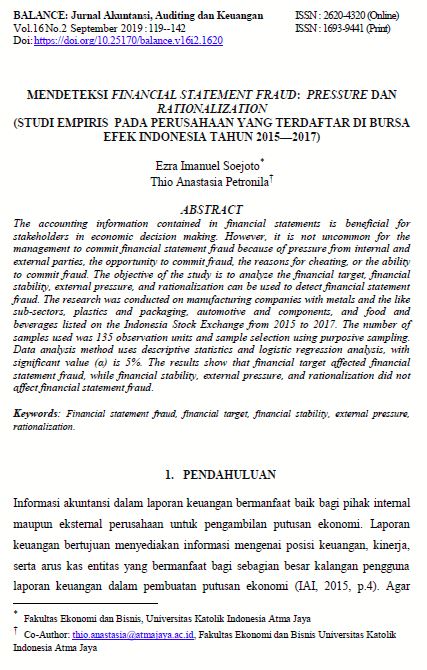MENDETEKSI FINANCIAL STATEMENT FRAUD: PRESSURE DAN RATIONALIZATION (STUDI EMPIRIS PADA PERUSAHAAN YANG TERDAFTAR DI BURSA EFEK INDONESIA TAHUN 2015—2017)
DOI:
https://doi.org/10.25170/balance.v16i2.1620Keywords:
financial target, Financial statement fraud, financial stability, external pressure, rationalizationAbstract
The accounting information contained in financial statements is beneficial for stakeholders in economic decision making. However, it is not uncommon for the management to commit financial statement fraud because of pressure from internal and external parties, the opportunity to commit fraud, the reasons for cheating, or the ability to commit fraud. The objective of the study is to analyze the financial target, financial stability, external pressure, and rationalization can be used to detect financial statement fraud. The research was conducted on manufacturing companies with metals and the like sub-sectors, plastics and packaging, automotive and components, and food and beverages listed on the Indonesia Stock Exchange from 2015 to 2017. The number of samples used was 135 observation units and sample selection using purposive sampling. Data analysis method uses descriptive statistics and logistic regression analysis, with significant value (α) is 5%. The results show that financial target affected financial statement fraud, while financial stability, external pressure, and rationalization did not affect financial statement fraud.
References
Bursa Efek Indonesia. (2018). Laporan keuangan & tahunan. www.idx.co.id.
Casabona, P. A. & Grego, M. J. (2003). SAS 99 – Consideration of fraud in a financial statement audit: A revision of statement on auditing standards 82, review of business. The Peter J. Tobin College of Business.
Ghozali, I. (2018). Aplikasi analisis multivariate dengan program IBM SPSS 25. Semarang: Badan Penerbit Universitas Diponegoro.
Ikatan Akuntan Indonesia. (2015). Standar akuntansi keuangan. Jakarta: Dewan Standar Akuntansi Keuangan Ikatan Akuntan Indonesia.
Listyaningrum, D., Paramita, P. D., & Oemar, A. (2017). Pengaruh financial stability, external pressure, financial target, ineffective monitoring dan rasionalisasi terhadap kecurangan
pelaporan keuangan (fraud) pada perusahaan manufaktur di BEI tahun 2012—2015. Journal of Accounting, 3 (3), p.774-798 (3).
Rachamania, A. (2017). Analisis pengaruh fraud triangle terhadap kecurangan laporan keuangan pada perusahaan makanan dan minuman yang terdaftar di Bursa Efek Indonesia periode 2013-2015. Jurnal Online Mahasiswa Bidang Akuntansi, 2 (2), p.523-569 (2).
Rezaee, Z. & Riley, R. (2009). Financial statement fraud: Prevention and detection (Edisi 2). New Jersey: John Wiley & Sons.
Sihombing, Rahayu, K. S. & Rahardjo, S. Nur (2014). Analisis fraud diamond dalam mendeteksi financial statement fraud: Studi empiris pada perusahaan manufaktur yang terdaftar di Bursa Efek Indonesia (BEI) tahun 2010-2012. Journal of Accounting, 3 (2), p.1-12 (2).
Skousen, C. J., Smith, K. R. & Wright, C. J. (2008). Detecting and predicting financial statement fraud: The effectiveness of the fraud triangle and SAS No. 99 (October 28, 2008). SSRN e journals.
Tiffani, L. & Marfuah. (2015), Deteksi financial statement fraud dengan analisis fraud triangle pada perusahaan manufaktur yang terdaftar di Bursa Efek Indonesia. Jurnal Akuntansi dan Auditing Indonesia (JAAI), 19 (2) p.112-125 (2). Universitas Islam Indonesia Yogyakarta.
Wolfe, D. T. & Hermason, D. R. (2004). The fraud diamond: Considering the four elements of fraud. ABI/ INFORM Collection, The CPA Journal, 74(12), p.38-42.
Yesiariani, M. & Rahayu, I. (2017). Deteksi financial statement fraud: Pengujian dengan fraud diamond. Jurnal Akuntansi dan Auditing Indonesia (JAAI),21(1) p.112-125 (1). Yogyakarta: Universitas Islam Indonesia.
Biduri, S. (2016). Pengaruh akuntansi akrual terhadap perilaku aparatur dengan perangkat pendukung sebagai variabel moderating, Prosiding Seminar Nasional Indocompac.
Bursa Efek Indonesia. (2018). Laporan keuangan & tahunan. www.idx.co.id.
Casabona, P. A. & Grego, M. J. (2003). SAS 99 – Consideration of fraud in a financial statement audit: A revision of statement on auditing standards 82, review of business. The Peter J. Tobin College of Business.
Ghozali, I. (2018). Aplikasi analisis multivariate dengan program IBM SPSS 25. Semarang: Badan Penerbit Universitas Diponegoro.
Ikatan Akuntan Indonesia. (2015). Standar akuntansi keuangan. Jakarta: Dewan Standar Akuntansi Keuangan Ikatan Akuntan Indonesia.
Listyaningrum, D., Paramita, P. D., & Oemar, A. (2017). Pengaruh financial stability, external pressure, financial target, ineffective monitoring dan rasionalisasi terhadap kecurangan pelaporan keuangan (fraud) pada perusahaan manufaktur di BEI tahun 2012—2015. Journal of Accounting, 3 (3), p.774-798 (3).
Rachamania, A. (2017). Analisis pengaruh fraud triangle terhadap kecurangan laporan keuangan pada perusahaan makanan dan minuman yang terdaftar di Bursa Efek Indonesia periode 2013-2015. Jurnal Online Mahasiswa Bidang Akuntansi, 2 (2), p.523-569 (2).
Rezaee, Z. & Riley, R. (2009). Financial statement fraud: Prevention and detection (Edisi 2). New Jersey: John Wiley & Sons.
Sihombing, Rahayu, K. S. & Rahardjo, S. Nur (2014). Analisis fraud diamond dalam mendeteksi financial statement fraud: Studi empiris pada perusahaan manufaktur yang terdaftar di Bursa Efek Indonesia (BEI) tahun 2010-2012. Journal of Accounting, 3 (2), p.1-12 (2).
Skousen, C. J., Smith, K. R. & Wright, C. J. (2008). Detecting and predicting financial statement fraud: The effectiveness of the fraud triangle and SAS No. 99 (October 28, 2008). SSRN e journals.
Tiffani, L. & Marfuah. (2015), Deteksi financial statement fraud dengan analisis fraud triangle pada perusahaan manufaktur yang terdaftar di Bursa Efek Indonesia. Jurnal Akuntansi dan Auditing Indonesia (JAAI), 19 (2) p.112-125 (2). Universitas Islam Indonesia Yogyakarta.
Wolfe, D. T. & Hermason, D. R. (2004). The fraud diamond: Considering the four elements of fraud. ABI/ INFORM Collection, The CPA Journal, 74(12), p.38-42.
Yesiariani, M. & Rahayu, I. (2017). Deteksi financial statement fraud: Pengujian dengan fraud diamond. Jurnal Akuntansi dan Auditing Indonesia (JAAI),21(1) p.112-125 (1). Yogyakarta: Universitas Islam Indonesia.
Zack, G.M. (2013). Financial statement fraud: Strategies for detection and investigation. New Jersey: John Wiley & Sons



